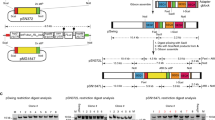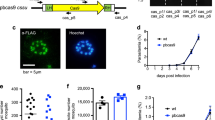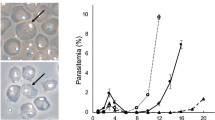Abstract
Genome manipulation in the malaria parasite Plasmodium falciparum remains largely intractable and improved genomic tools are needed to further understand pathogenesis and drug resistance. We demonstrated the CRISPR-Cas9 system for use in P. falciparum by disrupting chromosomal loci and generating marker-free, single-nucleotide substitutions with high efficiency. Additionally, an artemisinin-resistant strain was generated by introducing a previously implicated polymorphism, thus illustrating the value of efficient genome editing in malaria research.
This is a preview of subscription content, access via your institution
Access options
Subscribe to this journal
Receive 12 print issues and online access
$209.00 per year
only $17.42 per issue
Buy this article
- Purchase on Springer Link
- Instant access to full article PDF
Prices may be subject to local taxes which are calculated during checkout


Similar content being viewed by others
Accession codes
References
Straimer, J. et al. Nat. Methods 9, 993–998 (2012).
Bhaya, D., Davison, M. & Barrangou, R. Annu. Rev. Genet. 45, 273–297 (2011).
Jinek, M. et al. Science 337, 816–821 (2012).
Kirkman, L.A., Lawrence, E.A. & Deitsch, K.W. Nucleic Acids Res. 42, 370–379 (2014).
Cong, L. et al. Science 339, 819–823 (2013).
Bawankar, P., Shaw, P.J., Sardana, R., Babar, P.H. & Patankar, S. Mol. Biol. Rep. 37, 2125–2133 (2010).
Duraisingh, M.T., Triglia, T. & Cowman, A.F. Int. J. Parasitol. 32, 81–89 (2002).
Deitsch, K., Driskill, C. & Wellems, T. Nucleic Acids Res. 29, 850–853 (2001).
Pfander, C. et al. Nat. Methods 8, 1078–1082 (2011).
Crabb, B.S. et al. Cell 89, 287–296 (1997).
Moon, R.W. et al. Proc. Natl. Acad. Sci. USA 110, 531–536 (2013).
Deshmukh, A.S. et al. Nucleic Acids Res. 40, 5313–5331 (2012).
Ariey, F. et al. Nature 505, 50–55 (2014).
Ran, F.A. et al. Nat. Protoc. 8, 2281–2308 (2013).
Gilbert, L.A. et al. Cell 154, 442–451 (2013).
Ganesan, S.M. et al. Mol. Biochem. Parasitol. 177, 29–34 (2011).
Mali, P. et al. Science 339, 823–826 (2013).
Wu, Y., Sifri, C.D., Lei, H.H., Su, X.Z. & Wellems, T.E. Proc. Natl. Acad. Sci. USA 92, 973–977 (1995).
Collins, C.R. et al. Mol. Microbiol. 88, 687–701 (2013).
Salanti, A. et al. Mol. Microbiol. 49, 179–191 (2003).
Mancio-Silva, L., Rojas-Meza, A.P., Vargas, M., Scherf, A. & Hernandez-Rivas, R. J. Cell Sci. 121, 2046–2053 (2008).
Witkowski, B. et al. Lancet Infect. Dis. 13, 1043–1049 (2013).
Acknowledgements
We thank L. Mancio-Silva (Instituto de Medicina Molecular, Lisboa) and N. Siegel (Institute for Molecular Infection Biology, Wuerzburg) for critically reading the manuscript and PlasmoDB for the invaluable malaria-database support. F. Zhang laboratory (MIT, Boston) for deposition of pX330 in Addgene. A.B. Vaidya (Drexel University, Philadelphia) for pUF1 plasmid. D. Fidock laboratory (Columbia University, New York) for NF54EGFP strain. C. Buchrieser (Institut Pasteur, Paris) for lending Amaxa 4D electroporator (Lonza) and P. Escoll Guerrero (Institut Pasteur, Paris) for assistance. A. Nacer (Institut Pasteur, Paris) for help with immunofluorescence experiments. GenoScreen team, especially H. Blanquart and A. Gourbeyre, for sequencing. This work was supported by the Agence Nationale de la Recherche (ANR 11 JSV3 004 01 PlasmoPiggyBac), ERC Advanced Grant (PlasmoEscape 250320) and the French Parasitology consortium ParaFrap (ANR-11-LABX0024). Me.G. and Mo.G. were funded by ANR 11 JSV3 004 01 and J.-J.L.-R. by the Institut National de la Santé et de la Recherche Médicale (INSERM).
Author information
Authors and Affiliations
Contributions
J.-J.L.-R. devised the research experimental design with contributions from Me.G. Mo.G., Me.G. and J.-J.L.-R. performed the experiments. R.M.M. prepared the libraries for next-generation sequencing. C.R.M. conducted the bioinformatic analysis. A.S. provided funding. J.-J.L.-R. and Me.G. wrote the manuscript with contributions from all the authors.
Corresponding author
Ethics declarations
Competing interests
The authors declare no competing financial interests.
Supplementary information
Supplementary Text and Figures
Supplementary Figures 1–4, Supplementary Tables 1 and 2, and Supplementary Results (PDF 1964 kb)
Rights and permissions
About this article
Cite this article
Ghorbal, M., Gorman, M., Macpherson, C. et al. Genome editing in the human malaria parasite Plasmodium falciparum using the CRISPR-Cas9 system. Nat Biotechnol 32, 819–821 (2014). https://doi.org/10.1038/nbt.2925
Received:
Accepted:
Published:
Issue Date:
DOI: https://doi.org/10.1038/nbt.2925
This article is cited by
-
Increase of Plasmodium falciparum parasites carrying lumefantrine-tolerance molecular markers and lack of South East Asian pfk13 artemisinin-resistance mutations in samples collected from 2013 to 2016 in Côte d’Ivoire
Journal of Parasitic Diseases (2024)
-
Large DNA fragment knock-in and sequential gene editing in Plasmodium falciparum: a preliminary study using suicide-rescue-based CRISPR/Cas9 system
Molecular and Cellular Biochemistry (2024)
-
Recent Advances in CRISPR/Cas9-Mediated Genome Editing in Leishmania Strains
Acta Parasitologica (2023)
-
Genetic manipulations in helminth parasites
Journal of Parasitic Diseases (2023)
-
The transcriptional regulator HDP1 controls expansion of the inner membrane complex during early sexual differentiation of malaria parasites
Nature Microbiology (2022)



